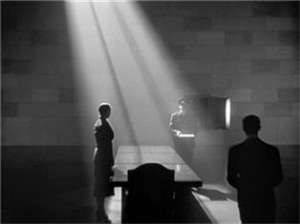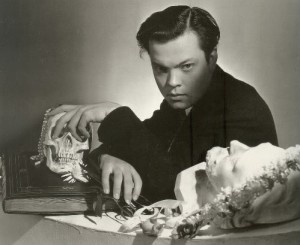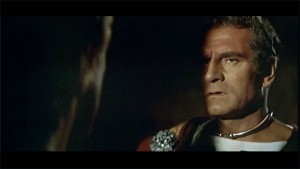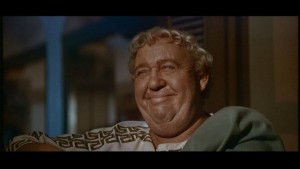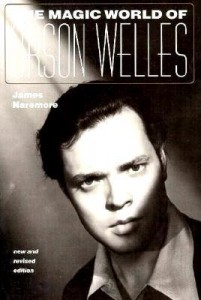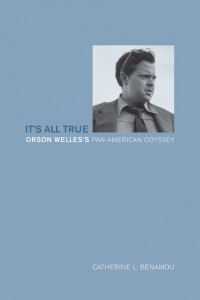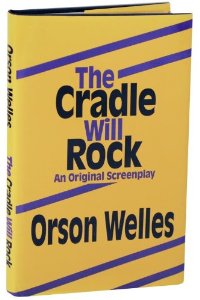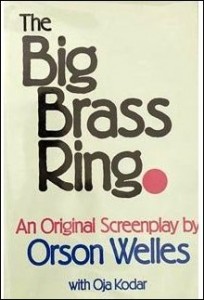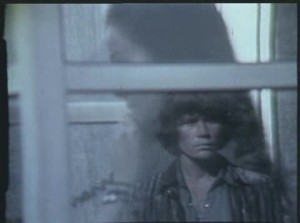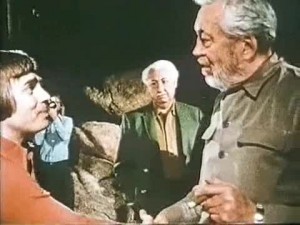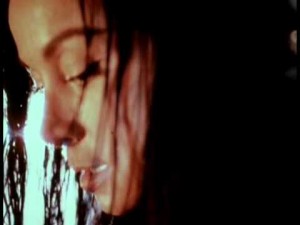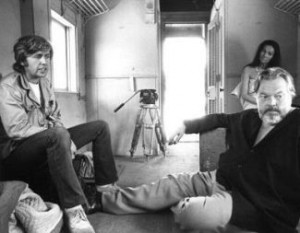From Cineaste 22, no. 3, 1996; reprinted with further comments in Discovering Orson Welles. — J.R.
Biographies of Orson Welles reviewed in this article:
Orson Welles: The Road to Xanadu, by Simon Callow (New York: Viking, 1995). 640 pp.
Rosebud: The Story of Orson Welles, by David Thomson (New York: Alfred A. Knopf, 1996). 461 pp.
Orson Welles, revised and expanded edition, by Joseph McBride (New York: Da Capo, 1996). 243 pp.
Two prevailing and diametrically opposed attitudes seem to dictate the way most people currently think about Orson Welles. One attitude, predominantly American, sees his life and career chiefly in terms of failure and regards the key question to be why he never lived up to his promise — “his promise” almost invariably being tied up with the achievement of Citizen Kane. Broadly speaking, this position can be compared to that of the investigative reporter Thompson’s editor in Citizen Kane, bent on finding a single formula for explaining a man’s life. The other attitude — less monolithic and less tied to any particular nationality, or to the expectations aroused by any single work — views his life and career more sympathetically as well as inquisitively; this position corresponds more closely to Thompson’s near the end of kane when he says, “I don’t think any word can explain a man’s life.”
The first attitude can be found in relatively undiluted form in six extended works by four authors — Charles Higham’s The Films of Orson Welles (1970) and Orson Welles: The Rise and Fall of an American Genius (1985), Robert L. Carringer’s The Making of Citizen Kane (1985; revised edition, 1996) and The Magnificent Ambersons: A Reconstruction (1993), Pauline Kael’s essay “Raising Kane” (1971 — reprinted most recently in For Keeps, 1994), and David Thomson’s recent biography Rosebud: The Story of Orson Welles (1996). A more diluted form of this attitude can be found in Simon Callow’s Orson Welles: The Road to Xanadu (1995), the first volume of a projected two- or three-volume biography that basically ends with the release of Citizen Kane and the stage production of Native Son, the last two projects in which Welles collaborated with John Houseman.
The second attitude can be found in André Bazin’s Orson Welles: A Critical View (1978), Jean-Pierre Berthomé and François Thomas’s Citizen Kane (1992), Frank Brady’s Citizen Welles (1989), Juan Cobos’s Orson Welles: España Como Obsesion (1993), Peter Cowie’s The Cinema of Orson Welles (1965; revised editions, 1973 and 1983), Barbara Leaming’s Orson Welles (1985), Joseph McBride’s Orson Welles (1972; revised edition, 1996), James Naremore’s The Magic World of Orson Welles (1978; revised edition, 1989), Esteve Riambau’s Orson Welles: Una Españia Inmortal (1993), and Orson Welles and Peter Bogdanovich’s This Is Orson Welles (1992) — to offer an incomplete but fairly up-to-date list. (Laura Mulvey’s interesting ideological and psychoanalytical reading of Kane in a 1992 BFI “Classic Film” monograph manages to absent itself from both of the positions outlined above.)
Though not all of the seven works representing the first attitude have received an equal amount of attention in the U.S., I think it would be fair to say that this still represents the most widely held mainstream position about Welles — the same position propounded in a recent documentary nominated for an Academy Award, The Battle over Citizen Kane. (By contrast, It’s All True: Based on an Unfinished Film by Orson Welles, a 1993 documentary, represents the second position.) The usual corollary of this attitude is a reading of Citizen Kane as a Hollywood picture rather than the first feature of an independent filmmaker that happens to use certain Hollywood resources. Paradoxically, many of those who single out Kane as Welles’s ultimate or only major achievement also routinely tend to support contemporary commercial filmmaking practices that would make such an achievement impossible and unthinkable today. For those, on the other hand, who tend to endorse Welles’s moves toward freedom, diversity, and independence even when this necessitated moving outside the Hollywood mainstream, the jagged path of his career can’t be charted according to any simple pattern of ascent or descent; there are peaks and valleys throughout. (For an artist who refused to repeat himself or turn his directorial talent into a commodity, this surely goes with the territory.) I should add that my preference for the ten books representing this second attitude is not a disinterested position; I translated and edited the first of these books and edited the last.
Another major distinction that can be made between these lists is that the first seven works all describe Welles as a deeply flawed, morally reprehensible human being and the last ten don’t. Significantly, only one of the authors in the first list, Carringer, ever had any personal contact with Welles — unlike most of those in the second list, including Bazin, Bogdanovich, Brady, Cobos, Leaming, and McBride, and possibly others as well.
Does this mean that Welles was capable of charming the birds off the trees, hoodwinking all potential biographers and critics? Not necessarily. My own impression, the only time I ever met him, was that he was abnormally self-absorbed, yet so alert to this fact that he sought to compensate for it by being downright solicitous to whomever he was with — a disarming trait, but far from being a smokescreen. Yet such was his sense of privacy that I wonder if part of the moral censure of Higham, Callow, and Thomson might stem from their resentment at feeling closed out. (Provocatively, Phillip Lopate suggested in Newsday that Callow’s book reads like the work of someone who expected he would have been sexually rejected by Welles — though Lopate perversely finds that Callow’s peevish tone gives The Road to Xanadu more of an interesting edge than a more respectful and less personal approach would.)
Most of my own sense of what Welles was like derives from numerous conversations I’ve had over the years with Oja Kodar, Peter Bogdanovich, the late Richard Wilson, and Gary Graver, as well as briefer encounters with John Berry, George Fanto, the late Fletcher Markle, Patricia Medina, Alessandro Tasca di Cuto, Ruth Warwick, and Beatrice Welles-Smith, among others. The composite picture I’ve gotten is far from complete, but it seldom gibes with the compulsive liar and shameless exploiter that emerges from Thomson’s book and periodically turns up in Callow’s. Some of this may arise from a temperamental difference in how we interpret the same data. Berry once described to me with relish his experience of holding up scenery outdoors for an entire morning during the shooting of a 1938 film intended as a prologue to the stage farce Too Much Johnson. When lunch arrived and Welles sat down to eat, Berry blurted out how hungry he was, whereupon Welles made a great show of offering him his own seat and plate. Berry was too intimidated to accept and went back to holding up the scenery.
The same anecdote is recounted in Rosebud — Thomson, who appears to have done virtually no original research, takes it from a Patrick McGilligan interview — but the resonance it takes on in this new setting is markedly different. Both versions of the story illustrate how adept Welles was at getting what he wanted from his employees, but when Berry told it to me, his overriding and unwavering affection for Welles was what mainly shined through (which makes this a typical and even archetypal Welles anecdote in my experience). In Thomson’s account, thanks to the surrounding context, it registers as one more instance of Welles’s hollow self-centeredness, another example of moral bankruptcy.
One lesson to be learned from this is how mythical and ideological a creature Welles remains, a site for the acting out of various fantasies. Critics and biographers of Franz Kafka don’t waste much time worrying their heads or clucking their tongues about why Kafka “failed to live up to his promise,” despite the fact that his own record of unfinished longer works — and his reluctance to make many of his shorter works available — is far worse than anything to be found in Welles. Curiously, even the most destructive Hollywood moguls, including those responsible for destroying the discarded Welles footage from The Magnificent Ambersons, The Stranger, and The Lady From Shanghai, have failed to elicit the sort of disapproval from writers that Higham and Thomson relentlessly heap on Welles.
The bad news about the recent Welles biographies by Callow and Thomson is that they pretend to an authoritativeness about the man’s inner nature and motivations that I doubt will be accepted by anyone who knew Welles intimately — or even by most of those like myself or Brady who encountered him only briefly and casually. Conscious or not, the agenda of both Callow and Thomson is to set certain ideological worries about Welles to rest rather than clarify what these worries represent, and exercising moral censure, puritanical or otherwise, is one of the most convenient methods available for carrying out this task. Another is the recourse of both biographers to a kind of spurious and, in Thomson’s case, irresponsible word-spinning about Welles’s inner life normally associated with fiction. In Callow’s book, this resembles the way a Stanislavsky-inspired actor might prepare for a role; in Thomson’s book, by his own admission, it often overlaps with the work undertaken by a novelist (although in this case, a rather self-indulgent and self-serving one). In both cases, this enterprise also calls to mind the efforts of certain British journalists to fill up a page with lively patter regardless of whether or not they have anything substantive to say. On this score, both Callow and Thomson are skillful writers whose skill often consists of creating smokescreens.
Although they both have functioned admirably in the past as critics, and their critical gifts never fully desert them here, the basic issue of whom they’re writing about — not simply what he did and why — is never wholly engaged. By contrast, one of the invaluable merits of McBride’s modest critical study on Welles — originally published in 1972, and substantially revised and expanded for its second edition— derives from the fact that he worked for Welles as an actor on the still-unfinished The Other Side of the Wind. This may make him more of a partisan, along with Berry, but it also gives his personal judgments some solid basis in experience. And in conscientiously updating the record on Welles’s peripatetic career, he offers a balanced survey of the work that can be warmly recommended as a useful starting point for anyone wishing to delve into the subject. His four-page bibliography, apart from being mainly limited to English-language entries, succinctly sums up the current state of Welles studies — quite unlike Thomson’s, which is nearly twice as long.
Although I think McBride underrates Othello and The Trial and overrates Macbeth and The Immortal Story, such disagreements are secondary to the fact that he has plenty of valuable and interesting things to say about all four. (His brilliant observation that Hitchcock’s The Wrong Man “could well serve as a step-by-step illustration of how to film the nightmarish aspect of Kafka’s world” should perhaps be set alongside Noël Carroll’s defense of The Trial as a faithful literary adaptation, found in Film Reader no. 3, 1978.) And his lengthy chapters on Citizen Kane and The Magnificent Ambersons, which take up almost a quarter of his text, manage to be both judicious and comprehensive.
***
As a writer, Simon Callow has two interlocking talents that make him especially well-suited to write about actors: a comprehensive understanding, through his own career as an actor, of what the craft of performance consists of, and a talent for performing on the page that might be regarded as an actorly form of writing. These gifts come together triumphantly in Charles Laughton: A Difficult Actor (1987), where Callow’s complex empathy for his subject is apparent on every page. Consider the following comparison between Laughton and Laurence Olivier, which shows Callow’s writing at its best:
Olivier and Laughton . . . could hardly be said to be practicing the same art. Laughton the deep-sea diver who had to keep coming up for air, Olivier the surfer whose skill took him to places he never meant to go; they had the sea in common, but that was all.
In Spartacus, the two modes can be seen side by side: Olivier . . . plays Crassus like a knife: it is an entirely linear performance with every point brilliantly made. His glacial patrician manner, his ruthless ambition, his strongdesire for his handsome young slave, are all cleanly and sharply indicated, is as if there were a thin black line drawn around the role. Laughton’s Gracchus has no such boundaries, no such definition. It spreads, floats, expands, contracts. The whole massive expanse of flesh seems to be filled with mind — thoughts are conceived, born and die in different parts of that far-flung empire. Sedentary for the most part, Gracchus seethes with potential movement. He is a jelly that has escaped the mould; Olivier’s (and Crassus’s) sharp knife can gain no purchase on it.
The close identification that Callow clearly feels with Laughton — as an eloquent ham, as a homosexual, as a multifaceted and educated man of the theater — isn’t matched by his troubled fascination with Welles, despite much valuable material in his new book about Welles’s acting. If he identifies with anyone in The Road to Xanadu, this is John Houseman, whose positions about Welles he tends to adopt wholesale, even where there appears to be some room for debate. However reliable Houseman’s memoirs may be on many Wellesian matters, my own research has repeatedly shown that he can’t be trusted on the issue of Welles as a writer; Callow, however, not only trusts him on this matter but regards him as the final arbiter on the subject. This means that on such matters as the War of the Worlds radio broadcast and the Kane script, Callow goes overboard in denying Welles creative input, even when this means ignoring or minimizing much of the contrary evidence available. (1)
Though Callow’s research into Welles’s career has clearly been extensive — which pays off in particular when it comes to descriptions of the stage productions — the determination to be authoritative as well as judgmental about Welles’s motives does not always have happy results. Stuart Klawans, in a dismissive review of The Road to Xanadu in The Nation, had many cogent points to make about its inadequacy in dealing with Welles’s politics, noting in particular its failure to mention the Popular Front. (For a detailed consideration of Welles’s leftist and liberal positions, Naremore’s book — still the best critical study of Welles available in any language— remains the only extended and reliable source.)
Some of the books on Welles to have appeared are debatable (such as Callow’s), and a few — such as the second books of Higham and Carringer — strike me as lamentable, but only Thomson’s biography deserves to be called a disgrace. (For the record, however, it has by far better illustrations than the McBride or the Callow.) Much as the 1994 third edition of his Biographical Dictionary of Film owes much of its dubious prestige to its implicit denial that anything important happened in cinema over the previous decade (2), Rosebud seems designed to give aid and comfort to amateur Welles sleuths who haven’t bothered to keep up with Welles scholarship over the same period. (And judging from Janet Maslin’s rave in The New York Times Book Review, it has already fully succeeded in that endeavor.) Thus the absence in the former book of any entries on Chantal Akerman, Hou Hsiao-hsien, Jon Jost, Abbas Kiarostami, Mohsen Makhmalbaf, Sergei Paradjanov, Mark Rappaport, Râúl Ruiz, Béla Tarr, or Edward Yang — to cite only the first ten names that come to mind — is matched by Thomson’s failure to acknowledge any of the important Welles film material that has come to light since his death (ranging from fragments to completed works), not to mention the second edition of James Naremore’s The Magic World of Orson Welles, the extensive research on and re-evaluation of It’s All True carried out by Catherine Benamou and Robert Stam, or the recent French and Spanish books cited above. Admittedly, Thomson cites Stam and praises my own Welles chronology in This Is Orson Welles in his bibliography, but there’s no evidence in his text that he’s given much thought to either. To assert, as he does of It’s All True, “There was never a movie there, only an extravagant, self-destructive gesture” — a judgment quoted with approval by Maslin — one either has to refute the massive counter-evidence or pretend that it doesn’t exist, and Thomson characteristically settles on the latter. (The same principle of outright denial underlines Maslin’s claim that Welles “cavalierly [absented] himself from the studio’s drastic re-editing of The Magnificent Ambersons,” an accurate paraphrase of Thomson at his worst.)
Both Callow and Thomson are disappointingly negligent when it comes to assessing Welles’s radio work in any detail — a major subject that still awaits a critical chronicler — but only Thomson is so lazy in this regard that it leads him to make gross blunders about Welles’s work as a whole. Thus Horse Eats Hat, one of his comedy stage productions, “reminds us on how very few occasions Orson Welles played anything strictly for laughs,” a line that literally throws out dozens of radio shows. Similarly, we learn that “Nothing [of the voodoo Macbeth] remains but still photographs and memories” — an assertion leading to a bogus theory about Welles’s attitude toward the production — which rules out the surviving newsreel footage of the play’s ending (some of which can be seen in The Battle over Citizen Kane). Elsewhere, “Welles was inclined to give [The Cradle Will Rock] scant attention in his history of what he had done,” which sounds fine until you consider that the most sustained piece of autobiography Welles ever wrote was a screenplay about that very production, cited in Thomson’s bibliography.
The problem with such gaffes is that they’re typical of Thomson’s text rather than exceptional; Rosebud is bent on demonstrating that Welles was a horrible person, incapable of loving anyone but himself, and it rarely allows facts or contrary opinions to get in its way. If Callow is neglectful and perhaps simply naïve about Welles’s politics, Thomson seems to go out of his way to misrepresent them: “Welles . . . always liked his revolutionaries to be sophisticated and well-heeled,” he notes at one point, cavalierly ruling out, among others, Jacaré — the central, heroic, real-life radical in the central episode of It’s All True. But since he elsewhere characterizes the footage from this episode, dealing with Jacaré and other poor Brazilian fishermen, as “picturesque but inconsequential material,” maybe it’s Thomson and not Welles who likes — indeed, requires — revolutionaries to be “sophisticated and well-heeled,” at least if they want to be considered consequential.
By the same token, Thomson tries to imply more than once that Welles’s enthusiasm for jazz and samba and his affection for black people must add up to some form of racism: “There is sometimes a perilous proximity of old-fashioned racial stereotype and yearning sympathy,” he notes on page 144 — neglecting, of course, to say which times, which might require at least a smidgeon of research — so that by the time he gets around to Welles playing a black man in Othello (on page 305), he can note that “There is no exploitation of that special racial-sexual paranoia that Welles must have encountered with the Voodoo Macbeth, by being in Brazil and in talks with Lena Horne.” “Must have”? Are we talking now about Welles’s paranoia or Thomson’s? If Thomson appears to be letting Welles off the hook in the second quote, the hook in question is plainly his own invention.
Clearly it’s Thomson’s lack of interest in It’s All True — a turning point in Welles’s career as an independent as opposed to Hollywood filmmaker — that leads to his idiotic claim that the deleted first two reels of The Stranger, simply by virtue of being set in South America, is “surely . . . a reference to It’s All True.” (A comparable lack of interest leads to the greatest single flaw in Carringer’s book on Ambersons, a study so deep in political denial that it fails to mention the title It’s All True even once.)
Even if one faults him for laziness, one can readily excuse Thomson for such relatively common errors as his assertions that Welles’s Shakespeare editions of the 30s “were only ever published by the Todd Press” (thereby ruling out Harper & Brothers’ 1939 updated versions), that “eventually Welles would make a villain and a spoilsport out of” RKO studio chief George Schaefer (contradicted sharply by my own interview with Welles, who passionately defended him throughout our meeting as a “good guy”), that Welles wanted Agnes Moorehead to play Lady Macbeth, that Patricia Medina was already married to Joseph Cotten when she played in Mr. Arkadin (their marriage was six years afterward), that Charlton Heston was a conservative in the 50s, that Welles’s last released documentary was called The Making of Othello (and not Filming Othello), and that Welles “liked” Barbara Learning’s biography (which he helped to promote but never read). Speaking personally, I can even forgive Thomson for chiding both Gore Vidal and me for praising The Big Brass Ring, an unrealized Welles script that I helped to get published and which he considers “as bad as anything Welles ever did or attempted.” (For Thomson, this script — which I still regard as corrosive and brilliant — is “an OW shopping list” and “one more lame try at the thriller genre.” Since Thomson’s critique is the first indication I’ve come across that The Big Brass Ring has anything to do with “the thriller genre,” this seems about as relevant as calling Kane a failed musical.)
What I find unforgivable about Rosebud is its often voiced desire to close down Welles research altogether, apparently motivated by the sentiment that since Welles clearly never delivered a second Kane to Thomson’s local video store, there’s no point in looking for anything else in his oeuvre, including unreleased work he’s never seen. “Perhaps, one day, something called Welles’s Quixote will emerge,” he writes at one point — clearly unaware that one already did emerge in Spain four years ago — and adds, “Yet I wonder if it should. . . . Its legend is tattered and complete enough. Actual screenings would be so deflating, so much less than the thought of existence,” etc. It’s another way of saying, “There was never a movie there.” But having seen close to three hours of edited or reedited Quixote footage — some of it breathtaking, much of it major Welles — I would argue that however inadequate the two-hour Spanish and English versions cobbled together in 1992 might be, this Quixote footage is considerably more exciting than the legend, and even some of the footage left out of the release version, which I’ve written about elsewhere (in Persistence of Vision, no. 11, 1995), has to be included among Welles’s most powerful and lasting achievements.
Of course, this footage doesn’t have the production values of Kane; it was shot in total independence, out of Welles’s own pocket, which means its chance of making it to Thomson’s video store even in its inadequate version is fairly unlikely. So Thomson, or any potential Welles scholar, has a hard choice to make: either to travel to the Filmoteca Española in Madrid to see most of the Quixote footage (and to Rome, where Quixote editor Mauro Bonnani possesses the rest), or to stay at home and spin theories about Welles’s degradation based on what hasn’t been seen. If Thomson had admitted such a choice exists, he might have at least tried to justify opting for the second course of action; he didn’t and hasn’t — opting instead, like most passive spectators, to let the video stores determine the Welles canon, for now and for the indefinite future.
And what about the almost-finished The Other Side of the Wind, the feature that Welles most wanted to release when he was still alive, still kept unseen by legal and financial entanglements? Having seen most of this projected feature — calculated to confound all Welles fans whose measure of his achievement remains stuck in the 40s — I wonder what its complex and shocking reflections on machismo, homophobia, Hollywood, cinephilia, eroticism, and late-60s media, not to mention its kamikaze style, might do to someone of Thomson’s tender sensibilities. Fortunately, we don’t have to wait. “One day, it may be freed,” he writes. “I hope not. The Other Side of the Wind should stay beyond reach” — for reasons comparable to his arguments about why Quixote should remain unseen (and why It’s All True should continue to be seen as an incomprehensible patchwork).
Perhaps Thomson should go further and argue for a retooling of the NEA, simply for the purpose of tracking down all remaining unreleased Welles footage and destroying it, thereby guaranteeing once and for all no future threats of disappointing his expectations or mocking his dashed Hollywood hopes. After all, we know in advance that whatever else The Other Side of the Wind might be, it isn’t another Citizen Kane. Come to think of it, that’s what keeps Welles so interesting.
Notes
1. The definitive piece of scholarship on the authorship of Kane — and sadly one of the least well known — is Carringer’s “The Scripts of Citizen Kane,” originally published in Critical Inquiry 5 (1978): 369–400, and reprinted in both Perspectives on Citizen Kane, edited by Ronald Gottesman (New York: G. K. Hall, 1996), 141–171, and Orson Welles’s Citizen Kane: A Casebook, edited by James Naremore (New York: Oxford University Press, 1994), 79–121. (2006)
2. Only slightly and inadequately amended in the expanded fourth edition. (2006)
-— Cineaste 22, no. 3, 1996

